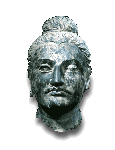
|
ARH 382 |

|
ARH 382 |
 |
>> | ID Lists | >> | ID List 5 |
Eclecticism and Gandharan Art:
- Prana - the vital breath developed through yogic practices. In art, associated with the treatment of the animal and human body in terms of swelling masses.
- Stucco - a soft sculptural medium, like plaster, applied to an already formed armature of wood and straw
- Grey schist - a grey metamorphic rock often used by Gandharan sculptors
A helpful and condensed resource for additional information can be found at Grove Art Online.
- Stylistic and representational elements that are referred to as "Parthian" and "Sasanian" form some of the richest and most confusing elements of Gandharan art. "Iranian" is an additional designation that could describe both the Parthian and Sasanian. What is meant by these terms?
- On the western edge of the Gandharan world there existed two successive empires centered in present-day Iran:
Because they occupied a similar territory, both empires had extensive borders and contacts with the ancient western worlds - the Greek, Roman, and Romano-Byzantium- and with the ancient eastern worlds - India and China. Over eight centuries of developed contacts with both the West and the East went into the legacy of these two empires and their art. Some of these elements were incorporated into Gandharan art without significantly altering Buddhist representational aims.
- The Parthian (mid-3rd c. BCE - 220s CE)
- The Sasanian (224 - 631 CE)
- Parthian elements - could be the dress of some figures: a knee-length tunic over trousers with the cuffs tucked into soft boots. The Parthians, although Iranian, were originally nomads of some repute and this dress shows up in the portrait statues of their own rulers. The Parthians also imported many elements from Greek and Roman art into their artistic vocabulary.
- Sasanian elements - appear occasionally in the dress of Bodhisattva figures in the form of long, multi-layered tunics with angular and schematic folds. These are similar to those found on figures represented in Sasanian silver plates (perhaps the most famous medium of Sasanian art). Another element associated with the Sasanians was the ornament on necklaces of the Bodhisattvas. The ornament was vegetal but not naturalistic - a sort of four-petalled flower.
|